Amb (princely state)
Amb also known as Feudal Tanawal was a princely state of the former British Indian Empire ruled over by chiefs of the Tanoli tribe of Pashtun descent.[1] The Tanoli submitted to British colonial rule in the 1840s.[2][3][4] Following Pakistani independence in 1947, and for some months afterwards,The nawabs of Amb remained unaligned. At the end of December 1947 the nawab of Amb state acceded to Pakistan, while retaining internal self-government. Amb continued as a Princely state of Pakistan until 1969, when it was incorporated into the North West Frontier Province now (Khyber-Pakhtunkhwa).
| Amb | |
|---|---|
| Princely state of Pakistan | |
| 19th century–28 July 1969 | |
 Flag | |
 Map of Pakistan with Amb highlighted | |
| Capital | Darband (now submerged under Tarbela Dam) Shergarh (summer residence) |
| Area | |
• | 585 km2 (226 sq mi) |
| History | |
• Established | 19th century |
• Disestablished | 28 July 1969 |
| Today part of | Khyber Pakhtunkhwa, Pakistan |
 |
| This article is part of the series |
| Former administrative units of Pakistan |
|---|
|
Original provinces
|
|
One-unit provinces |
|
Other subdivisions |
The state was named after the town of Amb. In 1972, recognition of the royal status of the Nawab was ended by the Government of Pakistan.
History
Contemporary research and scholarship stresses that 'Ambolina/Embolina' might have been Greco-Roman pronunciations of an ancient settlement that existed in this location near the banks of the Indus River since early Hindu times;[5] and it is most probable that this settlement was named as Ambhalina, or Ambalena, after the deity Amba Devi, also identified as Maha Devi, Shakti, Durga, Bhavani, Parvati, etc., several manifestations of the ancient Mother-goddess of Hinduism, who was specially venerated by the Gujjars and other tribes inhabiting the hill regions.[6]
Amb State, once known as Mulk e Tanawal (country/area of Tanawal), was the home of the Tanoli.[3][4] The early history of the region goes back to the centuries within the Mughal Empire, when around 1647 the Tanoli tribe conquered it and settled here on the banks of the Indus River and a wide area around it, which thus came to be known as Tanawal.
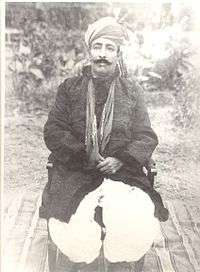
In 1854 British frontier officer General James Abbott postulated that Aornos was located on the Mahaban range south of modern Buner District. He proposed, as had Ranjit Singh's mercenary General Claude Auguste Court in 1839, to recognise Embolina as the village of Amb situated on the right bank of the Indus eight miles east of Mahaban. Be as it may, this is probably the location from which the Nawabs of Amb took their title much later.[7]
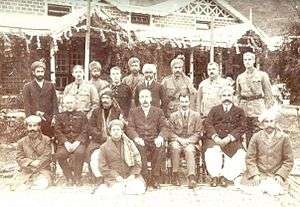

_Shergarh%2C_Mansehra.jpg)
Descent and ruling dynasty
The Tanoli describe themselves as purportedly Pashtuns[4] from the Ghazni area but are Barlas Turks.[1] The Tanoli submitted to British colonial rule in the 1840s.[2][3][4][8]
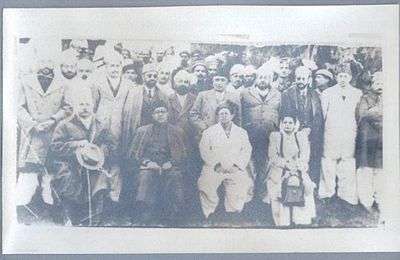
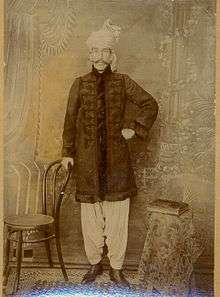
Painda Khan Tanoli: From about 1813, Painda Khan Tanoli is famed for his staunch rebellion against Maharaja Ranjit Singh's governors of Hazara. He was the son of Mir Nawab Khan Tanoli.
From about 1813, Painda Khan Tanoli spent a lifelong rebellion against the Sikhs, who, realizing the potential dangers of his rebellion, set up forts at strategic locations to keep him in check. Hari Singh Nalwa took this initiative during his governorship. In order to consolidate his hold on Tanawal and to unite the Tanoli people, Painda Khan Tanoli had to first contend with his major rivals within the tribe itself, i.e. the chiefs of the Suba Khani/Pallal khel section, whom he subdued after a bitter struggle.
Painda Khan set the tone for the regional resistance in Upper Hazara against Sikh rule. In 1828 he created and gifted the smaller neighbouring state of Phulra to his younger brother Madad Khan Tanoli.
Painda Khan also briefly took over the valley of Agror in 1834. The Swatis inhabiting it appealed to Sardar Hari Singh, who was unable to help them but in 1841, Hari Singh's successor restored Agror to Ata Muhammad Khan, the chief of that area, a descendant of Akhund Ahmed Sad-ud-din.[9]
Jehandad Khan Tanoli: Was the son of Mir Painda Khan Tanoli. In 1852, Jehandad Khan Tanoli was summoned by the President of the Board of Administration in relation to a murder enquiry of two British officers, supposedly on his lands. In fact, this related to the murder of two British Salt Tax collectors by some tribesmen in the neighbouring Kala Dhaka or Black Mountain area, which eventually led to the punitive First Black Mountain campaign/expedition of 1852. The President of the Board of Administration was Sir John Lawrence, later to be the Lieutenant-Governor of the Punjab, and he visited Haripur, in Hazara, where he invited many Hazara chiefs to see him, on various matters, at a general Durbar.[10] Jehandad Khan Tanoli was able successfully to establish his innocence and consolidate his position.
Jahandad Khan Tanoli's relationship with British India is summed in the following lines in a letter dated 8 January 1859 from R. Temple, Secretary to the Chief Commissioner of the Punjab, addressed to the Financial Commissioner of the Punjab: "'5. The term "Jagir" has never appeared to me applicable in any sense to this [Jehandad Khan's] hereditary domain [Upper Tannowul], for it was never granted as such by the Sikhs or by our Government; we upheld the Khan as we found him in his position as a feudal lord and large proprietor.'
Jehandad's son, Nawab Bahadur Sir Muhammed Akram Khan Tanoli, was given the title of Nawab in perpetuity by the British.
Nawab Sir Muhammad Akram Khan Tanoli: The next chief of the Tanolis, a son of Mir Jahandad Khan Tanoli, was Nawab Sir Akram Khan Tanoli KCSI 68–1907). He was a popular chief, and it was during his tenure that the fort at Shergarh was constructed, along with Dogah and Shahkot Forts. His rule was a peaceful time for Tanawal, with no major conflicts. He opposed to construct schools in the state, a advice that was given by British.
Nawab Sir Muhammad Khan Zaman Khan Tanoli: Nawab Khanizaman Khan Tanoli (K.C.I.E) succeeded his father, taking over the reins of power in Tanawal in Amb. He helped the British in carrying out the later Black Mountain (Kala Dhaka/Tor Ghar) expeditions.
Nawab Sir Muhammad Farid Khan Tanoli: Nawab Sir Muhammad Farid Khan Tanoli KBE had good relations with Muhammad Ali Jinnah and Nawabzada Liaqat Ali Khan. His contributions to the Pakistan movement have been acknowledged by letters from the Quaid e Azam.[11][12] In 1947 the Nawab of Amb, Mohammad Farid Khan Tanoli, acceded his state to Pakistan by signing the Instrument of Accession in favour of Pakistan.In 1969, the State was incorporated into the North West Frontier Province (now Khyber-Pakhtunkhwa) and in 1971 the Government of Pakistan ceased to recognize the royal status of the Nawab .
Nawab Muhammad Saeed Khan Tanoli: Nawab Muhammad Saeed Khan Tanoli, son of Muhammad Farid Khan Tanoli, the last Nawab of Amb, studied at the Burn Hall School in Abbottabad (now the Army Burn Hall College) and the Gordon College in Rawalpindi.[13] Nawab Saeed Khan Tanoli ruled for a period of just three years.
Nawabzada Salahuddin Saeed Khan Tanoli: Nawabzada Salahuddin Saeed Khan Tanoli is the present titular Chief of Tanolis and the nominal Nawab of Amb (titular/courtesy only) He is the son of Nawab Muhammad Saeed Khan Tanoli. He holds the record of being the youngest parliamentarian ever to be elected to the National Assembly of Pakistan and then went on to be elected five times to the National Assembly of Pakistan (from 1985 to 1997), a feat only achieved by seven other Pakistani parliamentarians, including the former Pakistani prime minister Nawaz Sharif.[14]
| Tenure | Chiefs of Tanawal and later Rulers of Amb (Tanawal) |
|---|---|
| 1772 – 1803 | (Mir) Haibat Khan Tanoli |
| 1803–1809 | (Mir) Hashim Ali Khan Tanoli (son of Mir Haibat Khan Tanoli and brother to Mir Nawab Khan Tanoli, following) |
| 1809–1818 | (Mir) Nawab Khan Tanoli |
| 1818–1844 | (Mir) Painda Khan Tanoli |
| 1844–1868 | Nawab Jahandad Khan Tanoli - Amb State founded in 1858 by British government recognition |
| 1868–1907 | Nawab Muhammad Akram Khan Tanoli |
| 1907 – 26 February 1936 | Nawab Khanizaman Khan Tanoli |
| 26 February 1936 – 1971 | Nawab Muhammad Farid Khan Tanoli -- Amb State ended and merged with NWFP Pakistan in 1971-72 |
Amb State Postal Service
Existing alongside British India were hundreds of Princely States, some 565 in all, but most of them did not issue postage stamps. Only around forty of the States issued their own postage stamps, and Amb State was one of them, having its own Postal Service. The rest used the stamps of the All India Postal Service.
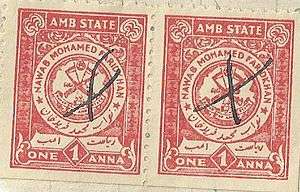
Present geography
Amb State consisted of the following present day Union Councils of Mansehra, Torghar and Haripur Districts:
Mansehra and Torghar Districts:
- Bandi Shungli
- Shergarh
- Karorri
- Nika Pani
- Darband
- Dara Shanaya
- Swan Miara
- Lassan Nawab
- Jhokan
- Palsala
- Perhinna
- Phulrraa
Haripur District:
See also
- Khyber-Pakhtunkhwa
- Politics of Pakistan
- British raj
- History of Pakistan
- List of Indian princely states
- Nawab
- Hazara, Pakistan
- Shergarh, Tanawal
References
- "Herald". Vol. 37 no. 4–6. 2006. p. 101.
The Tanolis' own history classifies them conflictingly as either Pakhtuns from the vicinity of Ghazni or Turks of the Barlas sub-clan.
Cite magazine requires|magazine=(help) - Allen, Charles (2012). Soldier Sahibs: The Men Who Made the North-West Frontier. Hachette. p. 96.
- Syed Murad Ali,"Tarikh-e-Tanawaliyan"(Urdu), Pub. Lahore, 1975, pp.84
- Ghulam Nabi Khan"Alafghan Tanoli"(Urdu), Pub. Rawalpindi, 2001, pp.244
- Prof Dr Ahmad Hasan Dani, AH Malik, HJ Fruhling et al, A Review of Ancient Settlements of the Upper Indus Region, paper, Central Asian and North Indian Studies conference proceedings, Vol XII, Tubingen, Germany, 1979
- See Nirmal Kumar Bose, 'Some aspects of traditional Indian Culture' research article published in the Journal of Asiatic Studies, Kolkata (old Calcutta), 1932, p 121
- Stein, Aurel (1929). On Alexander's Track to the Indus. Asian Publications. p. 125.
- Scott (1929), pp. 71-72.
- Hazara Gazetteer
- See The Hazara District Gazetteer 1883-8 (Lahore, 1884); and H. Lee, Brothers in the Raj: The Lives of John and Henry Lawrence (Karachi: Oxford UP, 2002)
- Quaid-I-Azam Mohammad Ali Jinnah Papers: First Series, Volume III: On the Threshold of Pakistan, 1–25 July 1947 By Mahomed Ali Jinnah, Z. H. Zaidi Contributor Z. H. Zaidi (Oxford University Press, 1997, ISBN 978-969-8156-07-7, ISBN 978-969-8156-07-7, 1120 pages, digitized 29 August 2008)
- Sana Haroon, Frontier of faith: Islam in the Indo-Afghan Borderland (Columbia University Press, 2008, ISBN 978-0-231-70013-9, ISBN 978-0-231-70013-9, 254 pages)
- Sack, John (1959). Report from Practically Nowhere. New York: Curtis Publishing Company. p. 199.
- Pakistan Election Commission – Unique Stats: http://www.ecp.gov.pk/content/uniquestats.html Archived 8 September 2008 at the Wayback Machine
External links
| Wikimedia Commons has media related to Amb (princely state). |